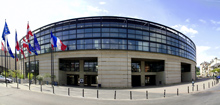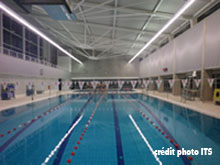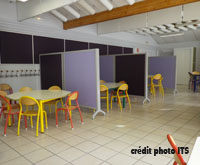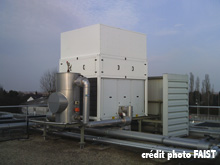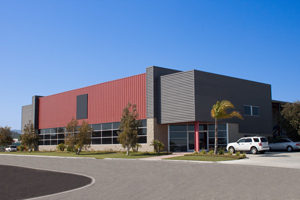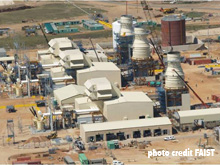Sound insulation in buildings is a major activity for ITS, whether it comes to engineering (including: metrology, Research and Development, simulation software, studies) or to the marketing of solutions, in relation to the various issues relating to the quality of constructions.
The main applications of ITS in the field of sound insulation in buildings are noise limitation and acoustical (auditive) comfort.
|
sound insulation in buildings |
Applications of ITS in the field of sound insulation of buildings: noise limitation
The sound insulation in buildings, as practiced by ITS, has to do with the fact that, in the construction, especially if it concerns Public-Access Buildings (PAB), noise constitutes one of the problems relating to the conditions of habitability in relation to which efforts must be made by the contracting authorities to meet the regulatory obligations to which they are subject, so as to protect the occupants of premises against exposure to noise.
The Decree of 25 April 2003 on the limitation of noise in educational establishments (e.g. elementary schools, colleges, high schools, regional institutions for adapted education, universities and higher education institutions) stipulates the requirements applicable to activity premises, especially in terms of weighted standardized level difference - from 30 dB(A) if it is a circulation to 55 dB(A) in the case of a noisy workshop - but also in terms of reverberation time (in octave ranges centered on 500, 1000 and 2000 Hz) for normally furnished and unoccupied premises. Thus 0.4 to 0.8 s is to be considered for a rest room, exercise room, kindergarten playground or for a teaching, music, studies, practical activities, catering room and a multipurpose room with a volume less than 250 m3 or for a medical or social room, an infirmary, sanitary facilities, an administration, a home, a meeting room, a library, a documentation and information center whereas 0.6 to 1.2 s is to be considered for teaching, music, study or practical activities rooms with a volume greater than 250 m3 (except for a noisy workshop) and also for a multi-purpose room with a volume greater than 250 m3. For a dining room with a volume greater than 250 m3, 1.2 s is the maximum allowable value, while for other premises and circulations accessible to students with a volume greater than 250 m3, the maximum value admissible is a function of the volume.In addition, under this decree, the equivalent absorption area of the absorbent coatings placed in horizontal circulations and halls with a volume of less than 250 m3 and in the basement must represent at least half of the floor area of the floors of considered premises.
The Decree of 25 April 2003 on the limitation of noise in hotels stipulates the applicable requirements, particularly in terms of weighted standardized level difference for rooms - 30 dB(A) in relation to the noise from external space to 35 dB(A) with respect to external delivery areas. In addition, pursuant to that order, the equivalent absorption area of the absorbent linings in the horizontal circulations connected to the rooms shall represent at least one quarter of the floor area of the premises in question. In addition, in accordance with this Decree, the standard sound pressure level of the noise generated in the rooms by equipment, whether collective or individual, of the building shall not exceed 30 dB(A), this value being increased to 35dB (A) when the equipment is installed in the room (heating, air conditioning).The Decree of 25 April 2003 on the limitation of noise in health facilities stipulates the applicable requirements, particularly in terms of weighted standardized level difference - 27 dB(A) for some internal circulations to 47 dB (A) for operating rooms, obstetrics and workrooms - but also in terms of average reverberation time (in octave intervals centered on 500, 1000 and 2000 Hz ) for normally furnished and unoccupied premises. Thus, in the case of premises with a volume of less than 250 m3, in terms of the maximum allowable value, 0.8 s is to be considered for a dining room, a room for lodging or care, a room for examination and consultation, a medical and nursing office, while 0.5 s is to be considered for a staff rest room, and while 1.2 s is to be considered for a public reception room. For other premises and circulations accessible to the public with a volume greater than 250 m3, the maximum admissible value depends on the volume. In addition, according to this decree, the equivalent absorption area of absorbent linings in indoor common circulations of accommodation and care sectors must represent at least one third of the floor area of these circulations. In addition, still under this decree, the standard sound pressure level, for the noise generated in a living room by building equipment outside this room must not exceed 30 dB(A) in general and 35 dB(A) for hydraulic and sanitary equipment in adjacent accommodation; the normalized sound pressure level, for the noise transmitted by the operation of a collective equipment of the building shall not exceed respectively 35 dB(A) if it for examination and consultation rooms, medical and nursing offices, waiting rooms and 40 dB(A) in treatment rooms, operating rooms, obstetrics and work rooms.
In the case of gyms (e.g. for gymnastics, athletics, volleyball, handball, basketball, tennis, fencing, table tennis), the standard NF P 90-207 Sports halls - Acoustics (either its application is mandatory or not) is the reference in France for taking into account the acoustic quality of such spaces, based on various performance indicators. among which airborne sound insulation between rooms - a minimum of 30 dB(A), isolation from the noise of the outdoor area, the reverberation time of the empty sports hall but with fixed equipment in the octave bands with a median frequency between 125 Hz and 4000 Hz - the maximum permissible value is a function of the volume - the noise level of the equipment (e.g. noise generated by the heating and ventilation / air conditioning devices) with a limit 45 dB(A) for the sound pressure level.
Moreover, and in an informative manner, the standard mentions imitated values for the decay of the sound level by doubling distance at the source, namely 2 dB(A) at 5 dB(A) according to the floor area (area) of the room.
As regards meeting rooms / training rooms, relaxation areas, restaurants, the standard NF S 31-080 Acoustics - Offices and associated areas - Acoustic performance levels and criteria by type of space (including the application of is not mandatory) is in some cases the reference in France for taking into account the acoustic quality of such spaces, based on various performance indicators, including the overall sound level, the reverberation time or the spatial sound decay, insulation from indoor noise, distinguishing 3 (quality) levels: current level, performance level, and high performance level.
|
swimming pool |
soundproof |
The reverberation control of public premises is one of the main activities of ITS.
|
|
Air Handling Unit (AHU) |
The limitation of equipment noise often motivates the recourse to ITS. |
|
Applications of ITS in the field of sound insulation of buildings: acoustical (auditory) comfort
The sound insulation in buildings, as practiced by ITS, has to do with the level of acoustical (auditory) comfort which is decisive for the quality of auditoriums (concert halls and operas, theaters, cinemas and other sound rooms) and for recording studios (radio, television, music) which constitute the most publicized applications of architectural acoustics.In addition to the reverberation time (i.e. the time required for the noise level in a room to decrease by 60 dB or in a ratio of 1 million to 1 when the noise source is instantly interrupted) and the spatial decay rate (i.e. the slope in dB of the spatial noise decay curve when the distance to the sound source is multiplied by two), which is sometimes referred to as a sound decay for doubling distance to the source, which are common indicators of ordinary rooms, the complex phenomena resulting from the reflection of acoustic waves due to the presence of walls delimiting a closed space require the evaluation of sophisticated additional acoustic parameters: clarity at 50 or 80 ms (C50, C80), early decay time EDT (Early Decay Time), standard intelligibility criterion STI, central time TS, definition D50, sound force sound G, lateral efficiency (LF and LFC).
ITS has appropriate simulation means for predicting the parameters related to the acoustic quality of such spaces, especially those intended for cultural creation or the perpetuation of a cultural heritage: the calculations are based on echograms (impulse responses of rooms) obtained (virtually ) by sound rays tracing.
In the field of sound insulation, ITS is involved in the definition and implementation of programs of technical measures to reduce noise exposure and improve the acoustic (auditory) comfort of buildings, whatever they are and in all contexts. Absorbent acoustic linings, either covering (at least partially) the walls that otherwise reflect sounds (especially when made of hard surfaces) - and thus possibly contribute to the unwanted reverberation phenomenon - (for some parts of walls / partitions and suspended ceiling if it is not perfectly absorbent) are implemented elsewhere than at the physical limits of the space considered e.g. in the form of suspended (absorbent) elements (baffles) and / or in the form absorbent elements fixed on vertical cables or maintained by other modes of fixation and / or in the form of (absorbing) barriers stationary or mobile on legs or on wheels which may also in some cases have a screen effect, protecting (limited) areas on the opposite side of a sound source are for ITS the acoustic common means for noise control and for the improvement of the acoustic ambiance inside a building (sometimes: industrial), while canopies and silencers are effective means to limit the noise of equipment (in particular: Heating Ventilation Air Conditioning hardware).
When required before or after soundproofing works (in the first case: to carry out an audit, to assess the conformity of a situation and - where appropriate - to contribute to the development of action plans, in the second case: to quantify and verify the performance of the insulation or reverberation reduction after implementation), measurements of acoustic indicators subject to regulation can be performed by ITS according to dedicated standards e.g. NF S 31-057 Acoustics – Verification of acoustic quality in buildings, Acoustics — Measurement of room acoustic parameters — Part 2: Reverberation time in ordinary rooms.
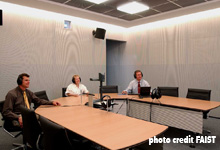
insulation from airborne noise and reverberation control are major for the sound comfort of many premises |
|
A comprehensive range of products and services for sound insulation in buildings
ITS intervenes in sound insulation in buildings: prevention of noise nuisance, improvement of acoustic comfort, soundproofing.
Whether it concerns the protection of occupants of a building from exposure to noise or their acoustic comfort in places with speech and listening, ITS offers a complete offer in terms of sound insulation, from engineering (if necessary: including on-site measurements) to turnkey realization (in relation with commercial partners) of projects in France or abroad.
ITS has its own measurement and calculation means in acoustics that can (with its personnel) be mobilized for interventions everywhere in France and in the neighboring countries to carry out a diagnosis and to find, in the field of sound insulation in buildings, solutions involving soundproofing and reverberation control equipment, whose performance is guaranteed, and which are manufactured and installed by specialized business partners whose professional credo is quality for an optimized consideration of issues of all kinds for each project.
|
a sufficient insulation with respect to external airborne noise (which the envelope must provide) and sound comfort inside the premises (linked to the sound reduction of floors and vertical separations, but also to the quality and quantity of sound-absorbing materials to control reverberation) are major challenges for many buildings |
the unusual noise levels generated by energy production equipment (e.g. heat engines, combustion turbines, generators) require exceptional acoustic performance for industrial buildings to be considered, to limit the highly undesirable amplification of sound levels inside the machine halls and to limit the transmission of noise to the neighborhood with additional functionalities such as the dismantling of the acoustic walls, the evacuation of the thermal power by means of sufficiently silent ventilation systems |
The offer of products and services of ITS in the field of acoustic insulation concerns in particular premises for young children, educational establishments, sports halls, restaurants, performance halls, offices and industrial buildings e.g in the energy production sector.
